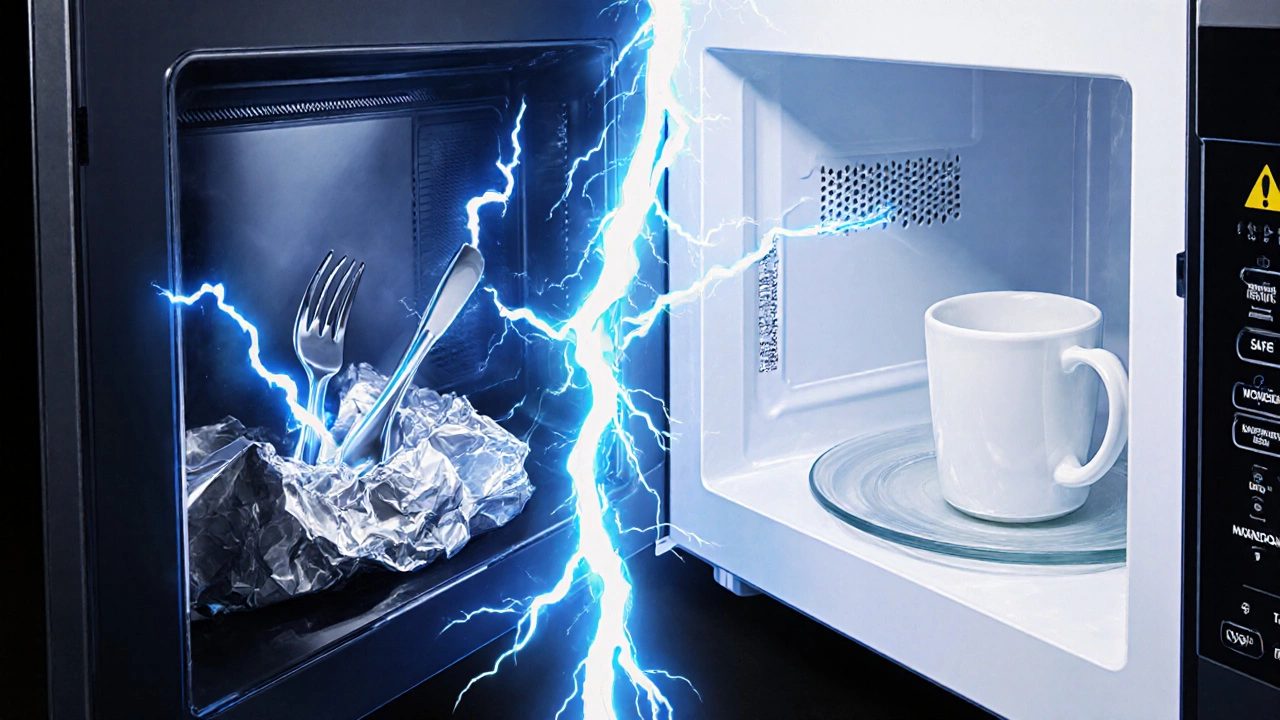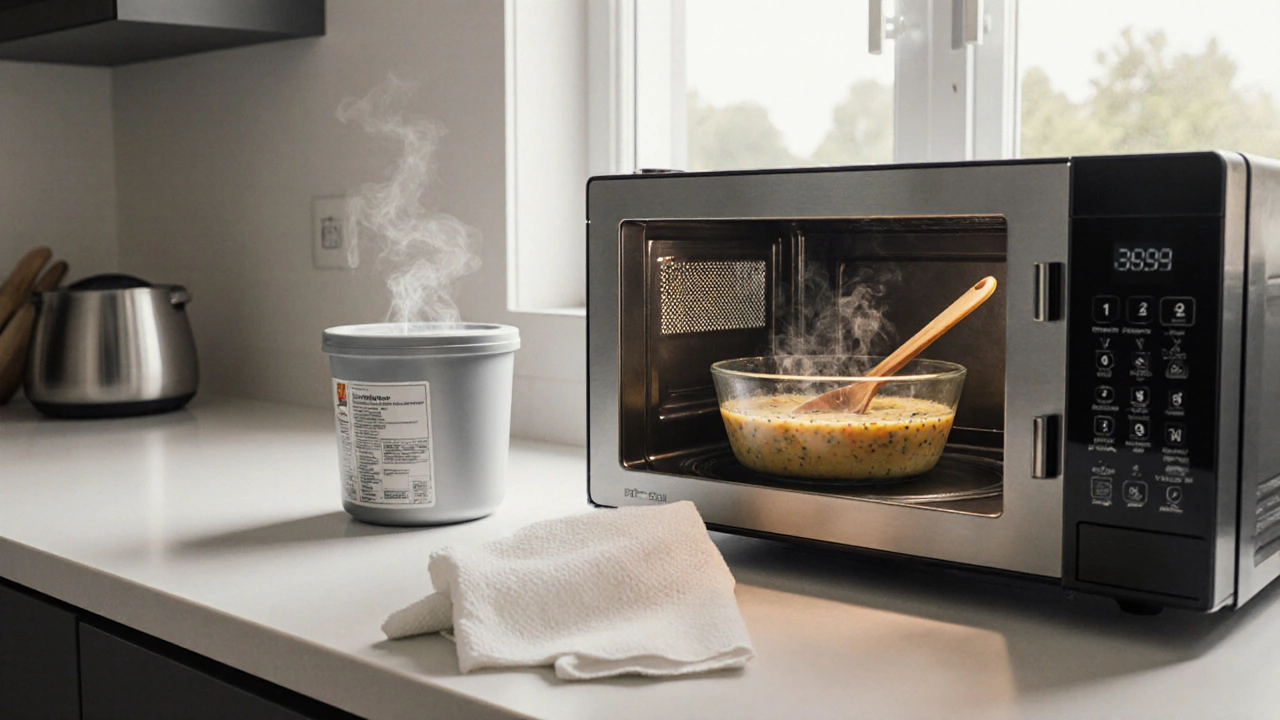Microwave Safety Checker
Check Your Microwave Safety
Millions of people use a microwave every day, but most don’t know how to use it right. You’ve probably seen someone heat a metal spoon, put a plastic container in that says "not for microwave use," or run it empty by accident. These aren’t just silly mistakes-they can damage your appliance, ruin your food, or even start a fire.
Do: Use Microwave-Safe Containers
Not all plastics, glasses, or ceramics are safe for the microwave. Look for the words "microwave-safe" on the bottom of the container. If it’s not labeled, test it: put the empty container in the microwave next to a cup of water. Run it for one minute. If the container stays cool and the water heats up, it’s probably safe. If the container gets hot, it’s absorbing microwaves and shouldn’t be used.
Glass and ceramic containers without metallic paint or trim are usually the safest bets. Avoid old or cracked dishes-they can shatter when heated. Even some takeout containers with metal handles or foil linings can spark. When in doubt, transfer food to a plain glass bowl.
Don’t: Put Metal Inside
Metal and microwaves don’t mix. Aluminum foil, metal utensils, twist ties, and even gold-trimmed plates can cause sparks, arcs, or even fires. The microwaves bounce off metal and concentrate in one spot, creating electrical discharges. This isn’t just a myth-it’s physics.
Some microwaves have special settings that allow small amounts of foil to shield parts of food (like drumstick ends), but only if the manual says so. Otherwise, keep all metal out. That includes stainless steel travel mugs, metal lids, and decorative plates with metallic glaze.
Do: Stir and Rotate Food
Microwaves heat unevenly. That’s why your soup might be boiling hot on one side and cold on the other. Always stir food halfway through cooking. If your microwave doesn’t have a turntable, manually rotate the dish every minute.
For dense foods like potatoes, eggs, or meat, poke holes before heating. Steam builds up inside, and without an escape route, it can explode. A baked potato can burst with enough force to damage your microwave’s interior. Eggs in the shell? Never microwave them whole. Even after cooking, they can explode when you bite into them.
Don’t: Run It Empty
Running a microwave with nothing inside is one of the worst things you can do. Microwaves need something to absorb the energy. If there’s no food or water, the waves bounce around inside the cavity and can damage the magnetron-the part that generates the microwaves. This can shorten the life of your appliance or cause it to fail entirely.
Even a damp paper towel or a cup of water left inside can prevent this. If you accidentally turn it on empty, stop it immediately. Don’t wait to see what happens.

Do: Cover Food to Trap Steam
Loosely covering food with a microwave-safe lid, paper towel, or vented plastic wrap helps food cook faster and more evenly. The trapped steam keeps food moist and reduces splatters. A paper towel is perfect for reheating pizza or bread-it keeps it from getting soggy or hard.
Don’t seal containers tightly. Pressure can build up and cause them to burst. Always leave a small gap for steam to escape. If you’re using plastic wrap, make sure it’s labeled microwave-safe and don’t let it touch the food directly.
Don’t: Heat Liquids Too Long
Water or other liquids heated in a microwave can superheat. That means they go past boiling point without bubbling. When you move the cup or add something like sugar or a spoon, it can suddenly erupt in a violent burst of steam. This can cause serious burns.
To prevent this, never heat water for more than a minute or two at a time. Use a clean, non-metallic object like a wooden stir stick or microwave-safe spoon in the cup while heating. It gives bubbles a place to form and prevents superheating. Let the liquid sit for 30 seconds after heating before handling it.
Do: Clean Regularly
Food splatters aren’t just messy-they can cause odors, smoke, and even fires if they build up. Wipe the inside after every use with a damp cloth. For stubborn stains, heat a bowl of water with a few drops of lemon juice or vinegar for two minutes. Let it sit for five minutes-the steam will loosen the gunk, and you can wipe it away easily.
Don’t use abrasive scrubbers or harsh cleaners. They can scratch the interior coating, which can lead to rust or arcing over time. A soft sponge and mild soap are all you need.
Don’t: Assume All Microwaves Are the Same
Not all microwaves heat the same way. Inverter microwaves adjust power levels smoothly, which is better for delicate foods like butter or chocolate. Traditional microwaves turn the magnetron on and off to simulate lower power, which can lead to uneven cooking. If you’re reheating leftovers or defrosting meat, know your microwave’s settings.
Check your model’s manual for wattage. A 700-watt microwave takes longer than a 1,000-watt one. Recipes often assume 800-1,000 watts. If yours is lower, add 20-30% more time. If it’s higher, reduce time to avoid overcooking.
Do: Let Food Stand After Cooking
Food continues to cook after you take it out. This is called carryover cooking. Letting food sit for 1-3 minutes lets heat spread evenly. That’s why your lasagna might still be cold in the center right after microwaving-it needs time to finish cooking.
Standing time is especially important for meats. A chicken breast pulled out at 160°F will rise to 165°F in a few minutes, reaching safe temperature without drying out. Cover it loosely with foil while it rests.
Don’t: Use It as a Dehydrator or Oven
Microwaves don’t brown or crisp food. They’re great for reheating, defrosting, and steaming-but not for baking cookies, roasting chicken, or making toast. Trying to use it as an oven will give you soggy, rubbery results.
If you want crispy skin on chicken or a golden crust on pizza, use an air fryer, toaster oven, or conventional oven instead. Microwaves are fast and efficient, but they’re not a replacement for all cooking methods.
Do: Know the Signs of a Failing Microwave
Sparks, unusual noises, smoke, or food taking much longer to heat than before? These are red flags. A microwave that runs but doesn’t heat food likely has a blown magnetron. A loud humming or buzzing sound could mean the high-voltage diode is failing.
If your microwave is over 10 years old and shows these signs, replacement is usually cheaper than repair. Modern microwaves are more energy-efficient and come with better safety features. Don’t risk fire or electrical hazards by keeping a faulty unit.
Don’t: Trust the "Quick Fix" Myths
You’ve heard them: "Microwaves destroy nutrients," "They cause cancer," "They make food radioactive." None of these are true. Microwaves use non-ionizing radiation-the same kind as your Wi-Fi router. They heat food by vibrating water molecules, not by altering its chemical structure.
Studies from the World Health Organization and the FDA confirm microwave cooking preserves nutrients as well as, or better than, boiling or steaming. The real danger isn’t radiation-it’s using the wrong containers or overheating food.
Also, microwaves don’t cook from the inside out. They penetrate about an inch into food. The center heats by conduction, just like in an oven. That’s why stirring and standing time matter.

